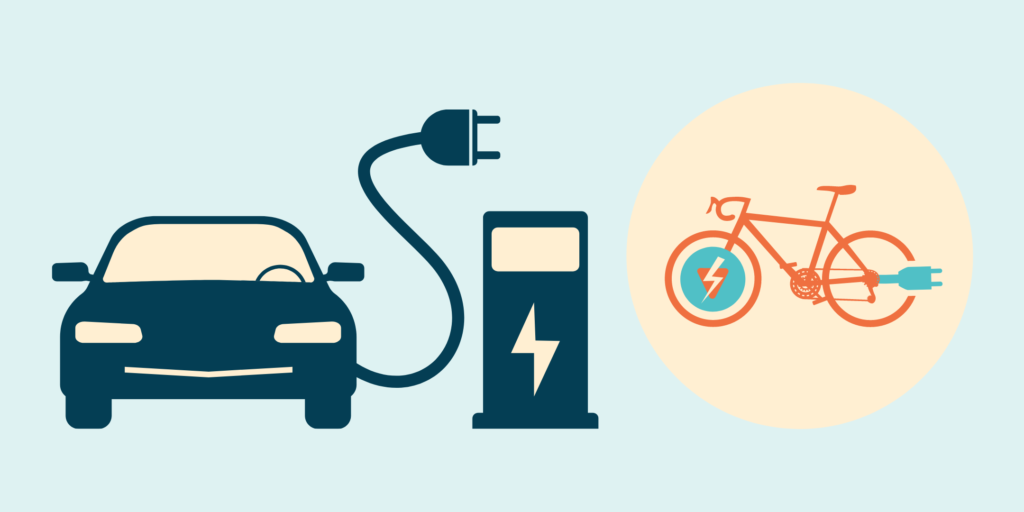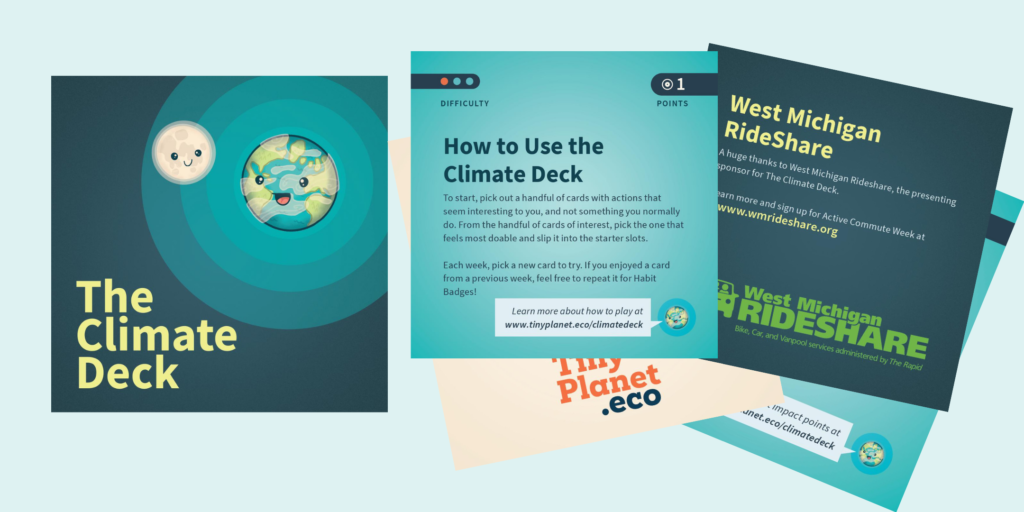
Good for you…and for the planet!
Do you ever get excited about new climate solutions only to learn there is no way you can actually participate in them?
Without a doubt, we need policy changes around the world to achieve systemic changes for wide scale impact. But there are ways we can amplify climate solutions AND even personally benefit along the way.
From saving money, improving your health, and boosting your mood, this curated list of climate solutions is here to help you as much as the planet! Let’s dive right in…
Solution 1: Renewable Energy

Nearly two-thirds of the US electric grid is powered by fossil fuels (aka, oil, natural gas, and coal). Burning these natural resources releases carbon dioxide and other greenhouse gases (GHG) into the atmosphere, accelerating an already urgent climate crisis. In total electric generation produces a quarter of all heat-trapping emissions globally.
If that isn’t bad enough, fossil fuels play a role in social inequities and racial disparities, especially regarding human health. Approximately 68% of Black Americans live within 30 miles of a coal-fired plant. Pollution, heat waves, and other related climate issues are linked to increased death rates, stillborn babies, and asthma in children (all of which occur at higher rates within the Black community). Adding insult to injury, these facilities can be more expensive to run than renewable power. (Make it make sense!)
What you can do about it:
Invest in Clean Energy
As the term “sustainability” becomes more popular amongst the general population, so does its influence on the stock market. The stock market has historically favored perpetual growth and profits. But this framework is unsustainable (and usually harmful) in the long run. According to Gallup, over half of all Americans own stocks. Those who own or are interested in owning stocks can collectively use their investments to shift the market away from short-term financial gains towards more sustainable outcomes.
Not stock market savvy? That’s ok! You can partake in mutual funds that focus on investments that uphold Environmental, Social, and Governance (ESG) criteria. These “green” funds may include a portfolio of investments in green transportation, alternative energy, waste reduction, or overall sustainable living. It’s time to rewrite what it means to be a shareholder. After all, what’s the point of profits if we destroy our planet and communities in the process?
Join a Community Solar Project
Residential rooftop solar has become more commonplace, but this technology is not yet accessible to everyone. Unfortunately, two-thirds of Americans can’t take advantage of rooftop solar. But you can still choose renewables even if you don’t own a home or have insufficient roof conditions! After all, access to renewable energy shouldn’t be limited to the privileged.
The more people who use renewable power, the better off we all are! Companies such as Arcadia and Clean Choice Energy are finding ways to connect anyone to renewable energy. Even better? Each partners with your existing energy provider to match your energy usage with renewable projects. No need to switch providers or disrupt your service!
Another option is community solar which is a type of solar project or purchasing program where customers can buy or lease a portion of solar panels in an array (aka solar farm). The energy generated from the array benefits multiple customers within a designated area and provides lessees and owners with a credit based on their share of the array.
You can learn more about Arcadia here or Clean Choice Energy here, or check out Community Solar to find nearby community solar projects here.
Solution 2: Electric Transit

Another way to decarbonize the planet is to shift transportation toward electrification and leave fossil fuels in the past. Let the dinosaurs stay dinosaurs!
Switching gas-powered vehicles to electric might seem marginally important, especially since 61% of the electric grid is powered by fossil fuels. However, the total emissions of an EV are typically lower than a gas-powered vehicle. Additionally, the hope is that we will continue to transition the electric power grid toward renewable energy sources (think wind, solar, and hydro) to ensure electric vehicles will one day achieve zero GHG emissions.
Beyond climate change concerns, conventional gas-powered vehicles also have economic consequences. When accounting for car payments, insurance, maintenance, and gasoline, vehicle expenses can be as high as housing costs for some Americans. Approximately 90% of US households pay for gasoline, with an average expense of $250 per month (that’s about $3,000 per year!) In other words, most Americans are dependent on fossil fuels and are at the mercy of oil suppliers. In recent months, we’ve seen a large uptick in gas prices: On average, a gallon of gas now costs $3.27, up drastically from the $2.18 average of the previous year.
What you can do about it
Consider Switching to an Electric Vehicle
With a goal of turning 50% of the car fleet electric by 2030, the Build Back Better plan will help incentivize Americans to purchase an electric vehicle (EV). The federal incentive to purchase an EV is currently $7,500, but if the Build Back Better plan can regain steam, this amount could reach $12,500. These credits would cover electric and hybrid vehicle purchases, battery packs made in the USA, and cars assembled in a unionized plant.
Although EVs have higher price tags than equivalent gas-powered vehicles, the lifetime savings of ownership (including sticker price, fueling costs, and maintenance expenses) ranges between $6,000 to $10,000. Switching to an electric vehicle also means swapping gas prices for electric expenses. If electricity costs $0.13 per kilowatt-hour, then it would cost approximately $9 to fully charge a 200-mile range EV. These low costs can be further offset with free charging ports (at work or home), charging during off-peak hours, or using renewable energy sources.
Long-range EVs are now holding their value as good as (or sometimes better than) gas-powered vehicles. Over time, the price of EVs is expected to become more competitive as battery technology improves and EVs continue to scale. If you’re in the market for a new vehicle, this may be the right time to finally make the switch!
Consider an Electric Bike
Of course, not everyone has the means to purchase a new vehicle, regardless of the long-term savings and incentives available (or perhaps you have already purchased a car!) Another alternative to decarbonize your commute is to supplement with an electric bike.
Electric bikes don’t require as much manual work as a regular bike which allows you to travel long distances without getting tired (20 to 30 miles on a single charge for basic models, and 100 miles for high-end models). Additionally, if you replace your gas-powered vehicle with an electric bike, you can save money on insurance fees, fuel expenses, and routine maintenance. You can save the planet, save money, and get your body moving! (We call that a win-win-win.)
This WIRED list is a good one to get started exploring eBike options!
Solution 3: Plant-rich Diet

A third of all human-related carbon emissions come from our food production. Raising farm animals for meat produces twice the amount of emissions of growing fruits and vegetables. Beef in particular accounts for a quarter of total food production emissions from the methane the cows produce (flatulence and burp-u-lence). In fact, producing one kilogram of beef equates to the same amount of emissions as 28 kilograms of wheat!
The emissions of global food production are major contributors to climate change. If the global climate reaches unsustainable levels, then a third of our global food supply could be at risk by the end of the century. In other words, our current food production can negatively impact future food production.
But the problems with raising farm animals expands beyond their emissions. Farm animals need land for grazing, but land is also used to grow livestock feed. In fact, we use more land to feed animals than we use to feed people! The demand for livestock “real estate” has resulted in an increase of deforestation (clearing forests for cattle ranching) and land degradation (depleting the soil of essential nutrients).
What you can do about it
Shift towards a Plant-Based Diet
We have the power to reduce carbon emissions on a global scale simply by changing our diets. A plant-based diet consists of whole foods sourced primarily from plants, including fruits, vegetables, legumes, seeds, nuts, healthful fats, and whole grains. Project Drawdown estimates that if 50% of the global population adopted a plant-based diet by 2050, then cumulative carbon emissions would reduce by 65.02 gigatons. If 75% of the population ate plant-based diets, then emissions would reduce by 91.72 gigatons. (For comparison’s sake, 9.3 gigatons of carbon were emitted globally in 2020 alone).
Adopting a plant-based diet is not only good for the environment, but also your health. People who consume vegetarian diets have a reduced risk of cardiovascular ailments, including obesity, hypertension, type 2 diabetes, and ischemic heart disease compared to those who incorporate meat into their diets. Plant-based diets tend to be high in fiber, complex carbohydrates, water content, and result in feeling fuller longer with increased energy.
So what do you say? Want to eat some plants to boost your health and save the planet?
Try Meatless Mondays
If quitting meat cold turkey (pun intended) sounds like too large of an undertaking, then start with smaller steps. Consider other creative ways to reduce your meat carbon footprint. You can designate a day (or several days) of the week to go meatless. Challenge yourself, or a friend or family member, to go vegetarian or vegan for an extended period of time. Be cognizant of the experience. Maybe you will discover your new favorite food or dish, or perhaps you will feel noticeably healthier or more energetic. You may surprisingly realize you don’t miss meat as much as you thought you would!
Solution 4: Reimagine Your Yard

Gas lawn mowers burn 800 million gallons of gas per year which represents 5% of US air pollution. The emissions create a toxic ozone layer at ground level. This is especially harmful to vulnerable populations, including young children, the elderly, and people with chronic respiratory illnesses. Although the EPA began regulating gas-powered mowers in 1995, they still cause a lot of preventable pollution. For example, running a gas-powered mower for an hour emits the same amount of air pollutants as 11 cars driving in the same timeframe. Additionally, refueling gas mowers is not efficient and is prone to accidents. An estimated 17 million gallons of gas are spilled each year; this is more than the 1989 Exxon Valdez spill that occurred in the Gulf of Alaska!
What you can do about it
Ditch the Gas Mowers
Over five million gas-powered mowers are sold every year in the US, but there are other alternatives available. Electric mowers still have a carbon footprint, but emissions are drastically reduced since electric companies are more highly regulated. Plus, the emissions of an electric mower won’t pollute your backyard and impact the health of your family and neighbors. Of course, the carbon footprint of your electric mower is further decreased if your electricity is sourced through renewable means.
Besides reduced emissions, electric mowers are also quieter, lighter, require less maintenance, and are half the price of their gas-powered counterparts. (To completely eliminate your carbon footprint, opt for manual reel mowers instead!)
Plant Strategically
Trees and plants are Mother Nature’s trustworthy carbon sequesters, using photosynthesis to absorb and capture carbon dioxide from the atmosphere. There are extensive ways your green thumb can be used to reimagine your garden to fight against climate change.
Instead of annuals, choose local perennial plants (fruits, nuts, asparagus, sweet potato, etc.) that naturally store more carbon and don’t require replanting. You can also incorporate cover crops, such as field peas, oats, and annual rye, into your garden. Cover crops refer to plants that aren’t harvested, but instead, help to keep the soil healthy with nutrients year-round (in addition to capturing carbon).
Lastly, you can improve your garden’s ability to store carbon by adding a layer of organic material (also known as mulching). Mulching helps to protect the soil from harmful elements, including wind erosion, stormwater runoff, and ultraviolet rays.
Solution 5: The Climate Deck

What if we could gamify small, repeatable actions that reduce your carbon footprint?
Well, get excited for The Climate Deck! It’s a new climate solution aimed to help individuals jumpstart new climate-friendly actions that reduce their carbon footprint.
Sign up for The Climate Deck waitlist here.
Individuals, families, and groups can use the deck to simplify their next best step towards reducing carbon pollution. The deck includes 40+ simple actions to choose from and a complementing reusable poster to keep making weekly shifts. Our digital Climate Tally tool can help you feel more connected to your weekly or monthly impact with estimated pounds of pollution prevented.
The benefits to you? It makes it easier to get started and keep going, instead of the enormous effort it can sometimes feel like it takes on your own. The deck is also designed around actions that don’t require you to buy a ton of additional items AND will likely save you money along the way.
What you can do about it
First – sign up for our waitlist here!
We will be doing a soft launch in March with early bird discounts.
Follow us on Instagram, Facebook, LinkedIn, or Twitter to stay in touch and help us spread the word!